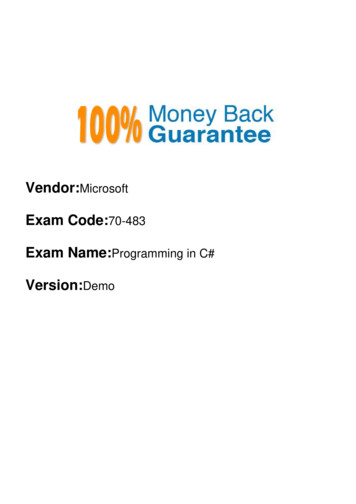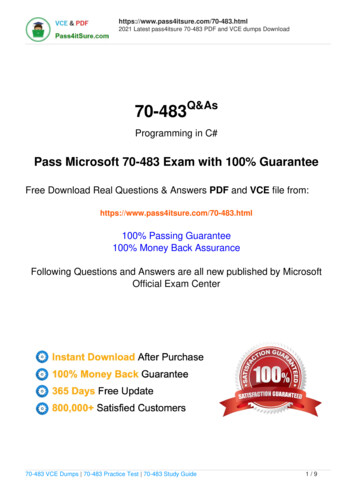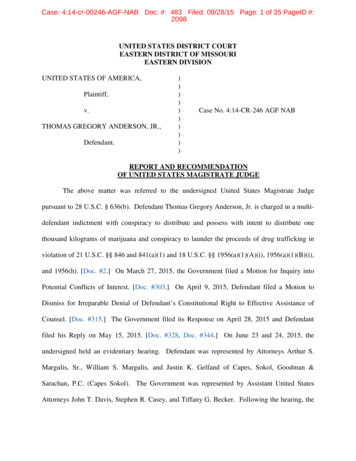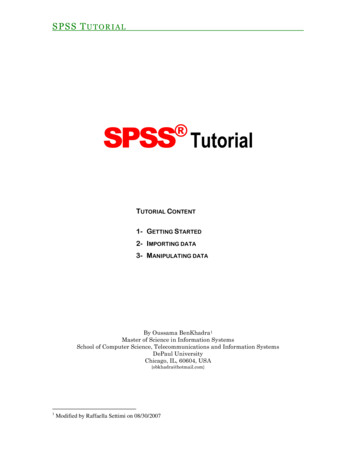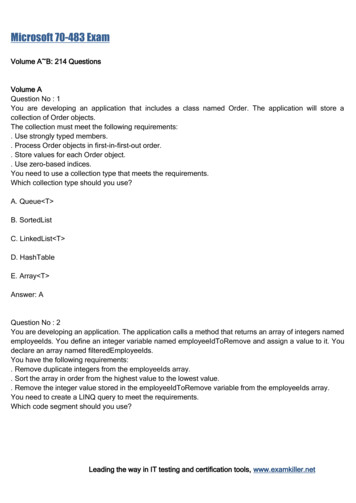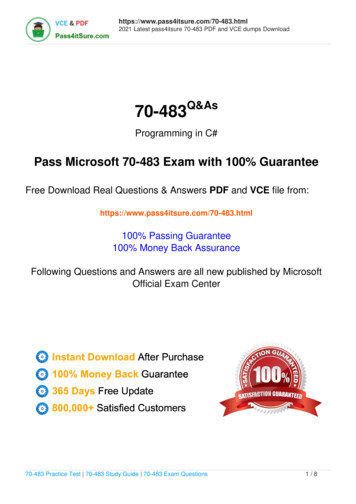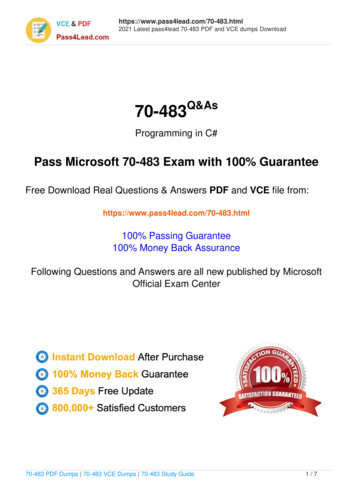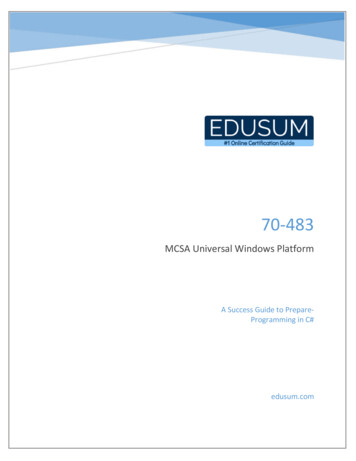
Transcription
70-483MCSA Universal Windows PlatformA Success Guide to PrepareProgramming in C#edusum.com
MCSA Universal Windows Platform- Success GuideTable of ContentsIntroduction to 70-483 Exam on Programming in C# . 2Microsoft 70-483 Certification Details: . 2Microsoft 70-483 Exam Syllabus: . 370-483 Sample Questions: . 6Answers to 70-483 Exam Questions: . 770-483 - Programming in C#pg. 1
MCSA Universal Windows Platform- Success GuideIntroduction to 70-483 Exam on Programmingin C#Use this quick start guide to collect all the information about Microsoft Programming inC# (70-483) Certification exam. This study guide provides a list of objectives andresources that will help you prepare for items on the 70-483 Programming in C# exam.The Sample Questions will help you identify the type and difficulty level of the questionsand the Practice Exams will make you familiar with the format and environment of anexam. You should refer this guide carefully before attempting your actual Microsoft MCSAUniversal Windows Platform certification exam.The Microsoft Programming in C# certification is mainly targeted to those candidates whowant to build their career in Microsoft Visual Studio domain. The Microsoft CertifiedSolutions Associate (MCSA) - Universal Windows Platform exam verifies that thecandidate possesses the fundamental knowledge and proven skills in the area of MicrosoftMCSA Universal Windows Platform.Microsoft 70-483 Certification Details:Exam NameMicrosoft Certified Solutions Associate (MCSA) - UniversalWindows PlatformExam Code70-483Exam Price 165 (USD)Duration120 minNumber of Questions45-55Passing Score700 / 1000Books / Training20483BSchedule ExamPearson VUESample QuestionsMicrosoft Programming in C# Sample QuestionsPractice ExamMicrosoft 70-483 Certification Practice Exam70-483 - Programming in C#pg. 2
MCSA Universal Windows Platform- Success GuideMicrosoft 70-483 Exam Syllabus:TopicDetailsWeightsImplement multithreading and asynchronousprocessing- Use the Task Parallel library (ParallelFor, Plinq,Tasks); create continuation tasks; spawn threads byusing ThreadPool; unblock the UI; use async andawait keywords; manage data by using concurrentcollectionsManage multithreading- Synchronize resources; implement locking; cancel along-running task; implement thread-safe methodsto handle race conditionsImplement program flow- Iterate across collection and array items; programManage program flow decisions by using switch statements, if/then, andoperators; evaluate expressions25-30%Create and implement events and callbacks- Create event handlers; subscribe to andunsubscribe from events; use built-in delegate typesto create events; create delegates; lambdaexpressions; anonymous methodsImplement exception handling- Handle exception types (SQL exceptions, networkexceptions, communication exceptions, networktimeout exceptions); catch typed vs. baseexceptions; implement try-catch-finally blocks; throwexceptions; determine when to rethrow vs. throw;create custom exceptionsCreate and use typesCreate types- Create value types (structs, enum), referencetypes, generic types, constructors, static variables,methods, classes, extension methods, optional andnamed parameters, and indexed properties; createoverloaded and overriden methods25-30%Consume types- Box or unbox to convert between value types; casttypes; convert types; handle dynamic types; ensureinteroperability with unmanaged code, for example,dynamic keyword70-483 - Programming in C#pg. 3
MCSA Universal Windows Platform- Success GuideTopicDetailsWeightsEnforce encapsulation- Enforce encapsulation by using properties, by usingaccessors (public, private, protected), and by usingexplicit interface implementationCreate and implement a class hierarchy- Design and implement an interface; inherit from abase class; create and implement classes based onthe IComparable, IEnumerable, IDisposable, andIUnknown interfacesFind, execute, and create types at runtime by usingreflection- Create and apply attributes; read attributes;generate code at runtime by using CodeDom andlambda expressions; use types from theSystem.Reflection namespace (Assembly,PropertyInfo, MethodInfo, Type)Manage the object life cycle- Manage unmanaged resources; implementIDisposable, including interaction with finalization;manage IDisposable by using the Using statement;manage finalization and garbage collectionManipulate strings- Manipulate strings by using the StringBuilder,StringWriter, and StringReader classes; searchstrings; enumerate string methods; format stringsValidate application input- Validate JSON data; data collection types; managedata integrity; evaluate a regular expression tovalidate the input format; use built-in functions tovalidate data type and content out of scope: writingregular expressionsDebug applicationsand implementsecurityPerform symmetric and asymmetric encryption- Choose an appropriate encryption algorithm;manage and create certificates; implement keymanagement; implement the System.Securitynamespace; hashing data; encrypt streams25-30%Manage assemblies- Version assemblies; sign assemblies using strongnames; implement side-by-side hosting; put anassembly in the global assembly cache; create aWinMD assembly70-483 - Programming in C#pg. 4
MCSA Universal Windows Platform- Success GuideTopicDetailsWeightsDebug an application- Create and manage compiler directives; choose anappropriate build type; manage programmingdatabase files and symbolsImplement diagnostics in an application- Implement logging and tracing; profilingapplications; create and monitor performancecounters; write to the event logPerform I/O operations- Read and write files and streams; read and writefrom the network by using classes in the System.Netnamespace; implement asynchronous I/O operationsConsume data- Retrieve data from a database; update data in adatabase; consume JSON and XML data; retrievedata by using web servicesImplement dataaccessQuery and manipulate data and objects by usingLINQ- Query data by using operators (projection, join,group, take, skip, aggregate); create method-basedLINQ queries; query data by using querycomprehension syntax; select data by usinganonymous types; force execution of a query; read, 25-30%filter, create, and modify data structures by usingLINQ to XMLSerialize and deserialize data- Serialize and deserialize data by using binaryserialization, custom serialization, XML Serializer,JSON Serializer, and Data Contract SerializerStore data in and retrieve data from collections- Store and retrieve data by using dictionaries,arrays, lists, sets, and queues; choose a collectiontype; initialize a collection; add and remove itemsfrom a collection; use typed vs. non-typedcollections; implement custom collections; implementcollection interfaces70-483 - Programming in C#pg. 5
MCSA Universal Windows Platform- Success Guide70-483 Sample Questions:01. When you create an abstract method, how do you use that method in aderived class?a) You must overload the method in your derived class.b) You must override the method in your derived class.c) Abstract methods cannot be used in derived classes.d) You need to declare the method as virtual in your derived class.02. Which the following statements about the this keyword is false?a) A constructor can use at most one this statement.b) A constructor can use a this statement and a base statement if the base statementcomes first.c) The this keyword lets a constructor invoke a different constructor in the same class.d) If a constructor uses a this statement, its code is executed after the invokedconstructor is executed.03. How do you execute a method as a task?a) Create a new Task object, and then call the Start method on the newly createdobject.b) Create the task via the Task.Run method.c) Create the task via the Task.Factory.StartNew method.d) All the above.e) None of the above.04. What is a strong name assembly?a) An assembly with the name marked as boldb) An assembly with a major and minor version specifiedc) An assembly with a full version specifiedd) An assembly with the culture info specifiede) A signed assembly05. Which statement selects an anonymous type?a) select { h.City, h.State }b) select hc) select new { h.City, h.State }d) select h.City, h.State06. Which of the following is a valid delegate definition?a) private delegate float MyDelegate(float);b) private delegate MyDelegate(x);c) private delegate MyDelegate(float x);d) private delegate void MyDelegate(float x);07. Which properties of an ADO.NET Command object must you set to executea stored procedure?a) CommandTypeStoredProcedureNameParametersb) ametersc) CommandTypeCommandTextParametersd) IsStoredProcedureCommandTextParameters70-483 - Programming in C#pg. 6
MCSA Universal Windows Platform- Success Guide08. How can you deploy a private assembly?a) By running gacutil.exeb) By adding a reference to the assembly in Visual Studioc) By copying the file in the Bin folder of the applicationd) By copying the file in C:\Windows folder09. Which of the following statements about statement lambdas is false?a) A statement lambda can include more than one statement.b) A statement lambda cannot return a value.c) A statement lambda must use braces, { }.d) If a statement lambda returns a value, it must use a return statement.10. Which where clause returns all integers between 10 and 20?a) where i 10 and i 20b) where i 10 && i 20c) where i gt 10 and i lt 20d) where i gt 10 && i lt 20Answers to 70-483 Exam Questions:Question: 01Answer: bQuestion: 02Answer: bQuestion: 03Answer: dQuestion: 04Answer: eQuestion: 05Answer: cQuestion: 06Answer: dQuestion: 07Answer: cQuestion: 08Answer: b, cQuestion: 09Answer: bQuestion: 10Answer: bNote: If you find any typo or data entry error in these sample questions, we requestyou to update us by commenting on this page or write an email onfeedback@edusum.com70-483 - Programming in C#pg. 7
70-483 Author: edusum.com Subject: MCSA Universal Windows Platform Keywords: 70-483 PDF, 70-483 VCE, 70-483 Dumps, 70-483 Questions, Microsoft Programming in C# Dumps, MCSA Universal Windows Platform Certification Questions Created Date: 1/4/2019 4:34:36 PM
